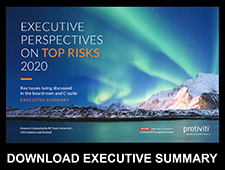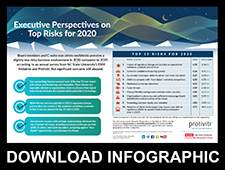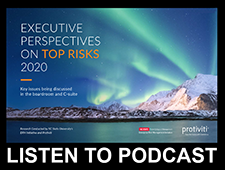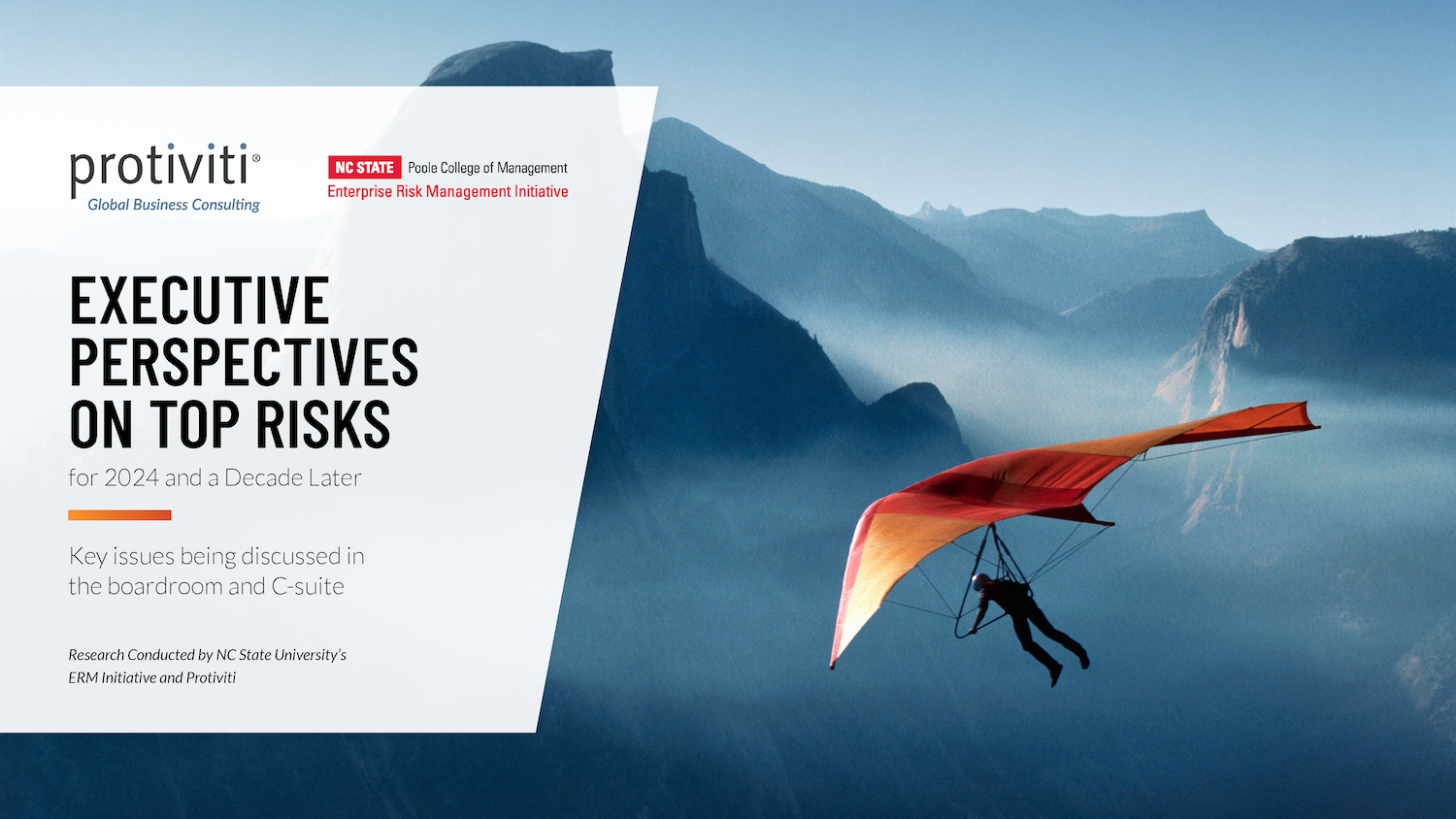Top Risks Report 2020: Executive Perspectives on Top Risks for 2020
REPORT: Executive Perspectives on Top Risks for 2020
The ERM Initiative in the Poole College of Management at NC State University, in conjunction with global consulting firm Protiviti, annually surveys boards of directors and C-suite executives about risks on the horizon for the upcoming year. This report, 2020 Executive Perspectives on Top Risks, highlights top risk concerns on the minds of executives for 2020.
Video Summary: 2020 Executive Perspectives on Top Risks Survey
Overall Riskiness of Global Business Environment
Our eighth annual research report assesses the concerns of 1,063 board members and executives globally, across a variety of industries. This year’s respondents indicate that the global business environment has a slightly less risky outlook for 2020 relative to 2019, after seeing an overall increase in the risk environment from 2018 to 2019. Despite this overall general shift towards a slightly lower risk concern for 2020, a majority of respondents still rate each of the top 10 risks as a “Significant Impact” risk.
Interconnected Risks Related to Talent, Culture, Technology and Innovation
Boards and C-suite leaders across the globe are most concerned about the escalating competition for specialized talent and their organizations’ culture and the ability to advance their digital maturity and embrace the transformative opportunities of technology. Nearly half of the top risks this year are related to culture and attracting and retaining top talent. This is happening at a time when organizations need to execute increasingly complex strategies to navigate the rapidly changing digitally-based business environment.
Economic Concerns Increase Noticeably
While several of the risks remain consistent with findings from previous years, including concerns around regulation, operational resilience, privacy management and information security, this year’s results show an escalation of anxiety related to overall economic issues across domestic and international markets – climbing from number 11 last year to the number two risk concern for 2020.
Concerns Over Operational Capabilities Have Strategic Underpinnings
Six of the top 10 risks reflect operational risk concerns, suggesting on the surface that respondents continue to be focused on operational issues to a greater extent than strategic or macroeconomic risks. This remains consistent with 2019, when seven of the top 10 risks related to operational concerns. Uncertainties surrounding their organizations’ infrastructure and core operations are creating challenges for their leaders to manage. However, these operational issues have strategic underpinnings, meaning they may present multiple considerations in strategy setting or may be perceived as a threat to successful execution of the strategy.
The Top 10 Risks for 2020
Survey respondents were asked to rate 30 different risks involving macroeconomic, strategic, and operational issues. Following are the top 10 risks identified in the “Executive Perspectives on Top Risks for 2020” report:
- Regulatory changes and scrutiny may heighten, noticeably affecting the manner in which our products or services will be produced or delivered
- Economic conditions in markets we currently serve may significantly restrict growth opportunities for our organization
- Our organization’s succession challenges and ability to attract and retain top talent in a tightening talent market may limit our ability to achieve operational targets
- Our existing operations, legacy IT infrastructure, and insufficient embrace of digital thinking and capabilities may not meet performance expectations related to quality, time to market, cost and innovation as well as our competitors, especially new competitors that are “born digital” and with a low cost base for their operations, or established competitors with superior operations
- Resistance to change may restrict our organization from making necessary adjustments to the business model and core operations
- Our organization may not be sufficiently prepared to manage cyber threats that have the potential to significantly disrupt core operations and/or damage our brand
- Ensuring privacy/identity management and information security/system protection may require significant resources for us
- Our organization’s culture may not sufficiently encourage the timely identification and escalation of risk issues that have the potential to significantly affect our core operations and achievement of strategic objectives
- Sustaining customer loyalty and retention may be increasingly difficult due to evolving customer preferences and/or demographic shifts in our existing customer base
- The adoption of digital technologies (e.g., artificial intelligence, robotics, natural language processing) in our organization may require new skills that either are in short supply or require significant efforts to upskill and reskill existing employees
Continued Investment in Risk Management Processes
Interestingly, while respondents indicate that they are somewhat less likely to devote additional time or resources to risk identification and management over the next 12 months relative to their plans in the prior year, that level of investment is still higher than two years ago, suggesting a continued desire to invest in strengthening risk management efforts. The ever-changing risk landscape in today’s fast-paced global business environment is prompting boards and senior executives to closely scrutinize the approaches to proactively address emerging risks. Boards of directors and executive management teams are recognizing that they cannot afford to manage risks casually on a reactive basis, especially considering the rapid pace of disruptive innovation and technological developments in an ever-advancing digital world.
Overview of Report
The 2020 Executive Perspectives on Top Risks survey was conducted in the fall of 2019, and respondents represent organizations across the globe in the public and private sectors. Over half of respondents’ companies have annual revenues of $1 billion or more. The survey report provides detailed insights broken out by size and type of company, respondent role, industry and geographical region.
Additional Resources Available to Learn More
In addition to the full report, 2020 Executive Perspectives on Top Risks from Protiviti and NC State University, you may also download an Executive Summary and Infographic at the links below. A podcast highlighting the key results is also available.
Jump start 2020 and register for our upcoming workshops and conferences. For a list of current ERM events, click here.
Webinar on December 18, 2019 | 1.3 CPE Credit Hours from Protivit
A complimentary 75-minute webinar exploring the implications of the survey results will be held on December 18 at 4:00 p.m. EST, featuring NC State’s Dr. Mark Beasley and Protiviti’s Jim DeLoach and Pat Scott.
Original Article Source: “2020 Executive Perspectives on Top Risks”Protiviti, 2020
Partnership Between

- Categories:
- Types:






